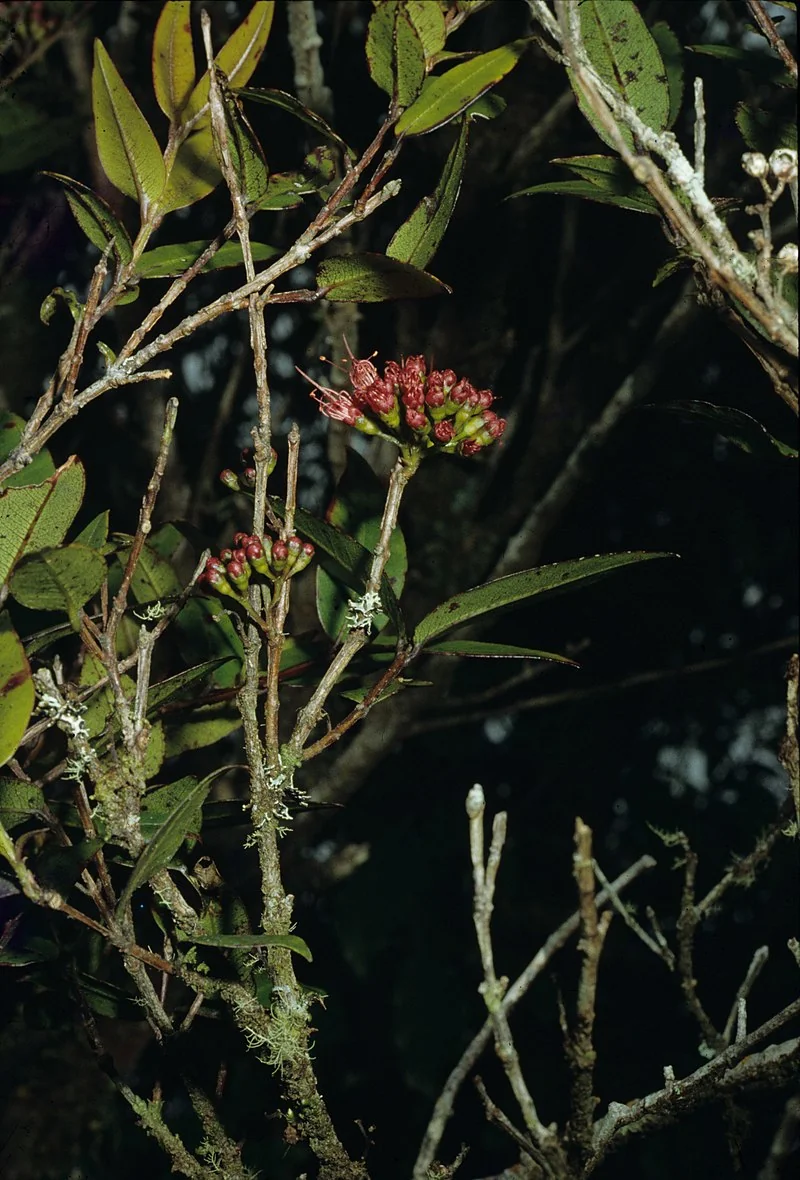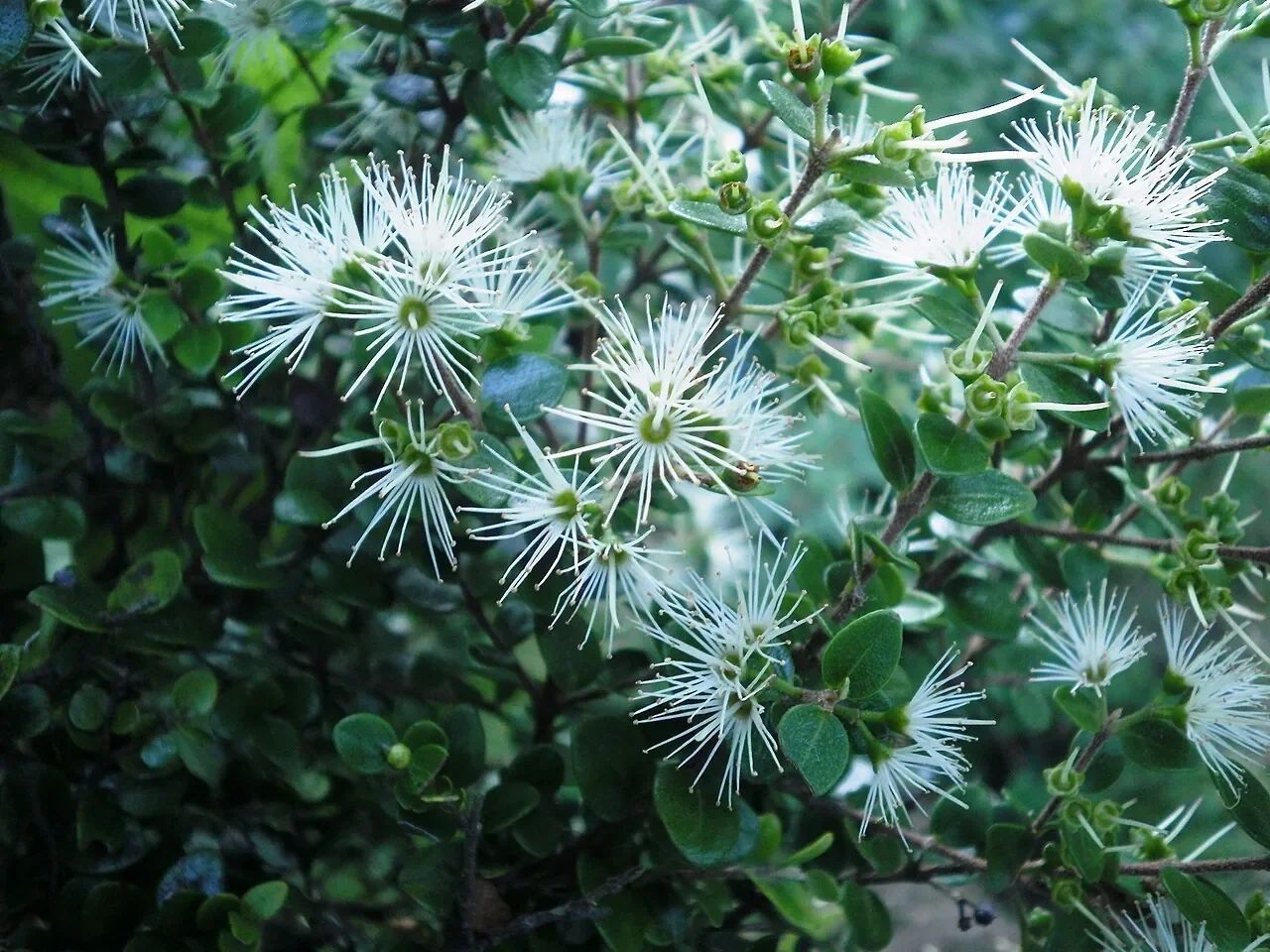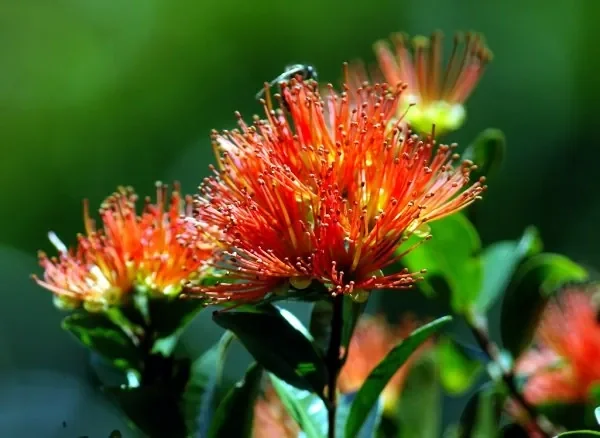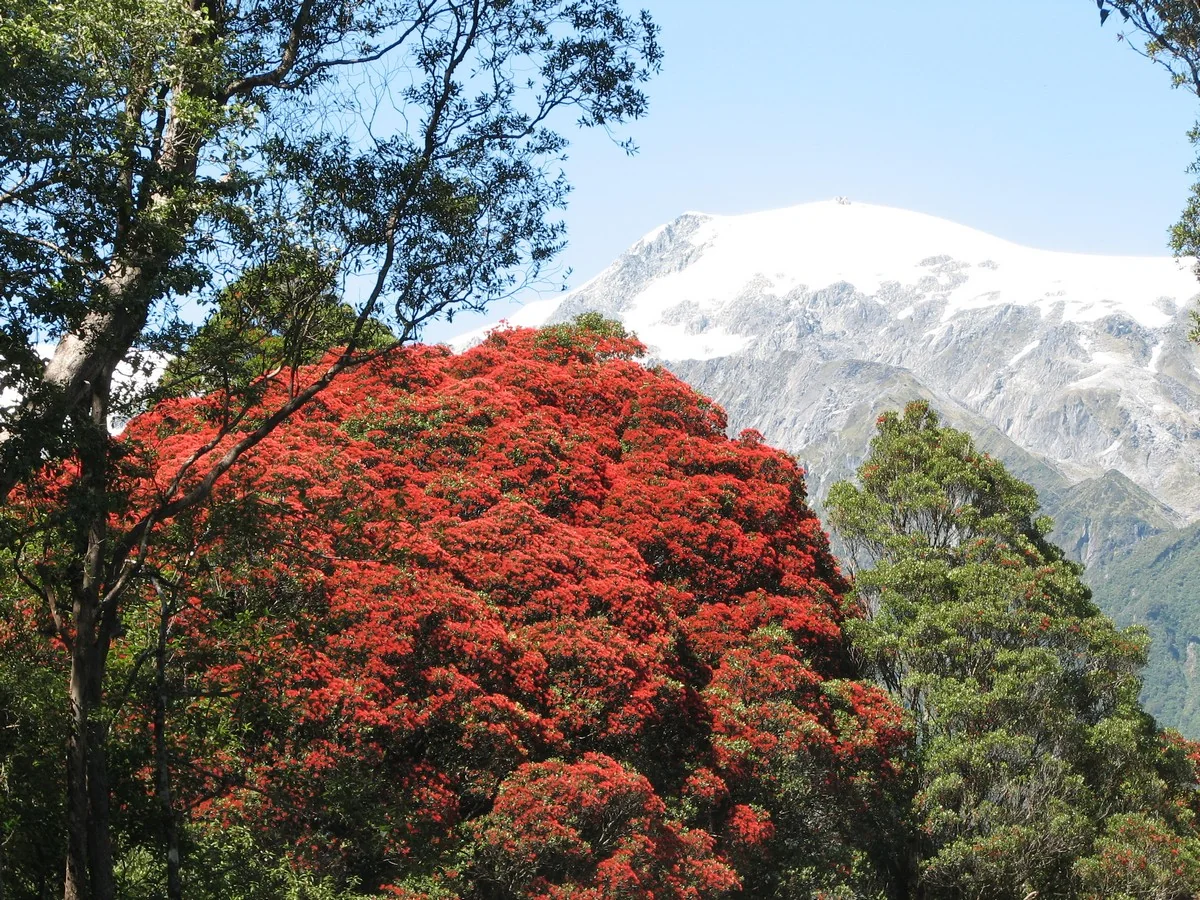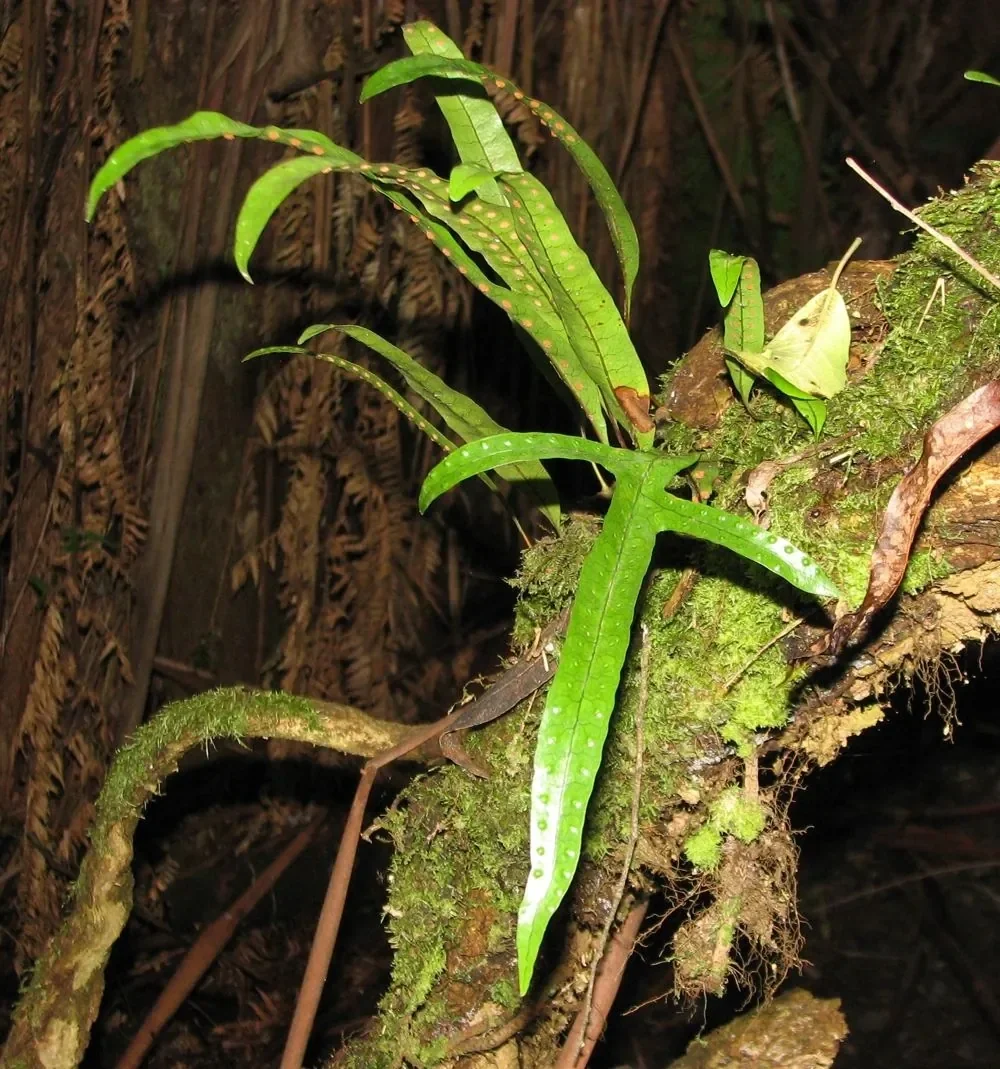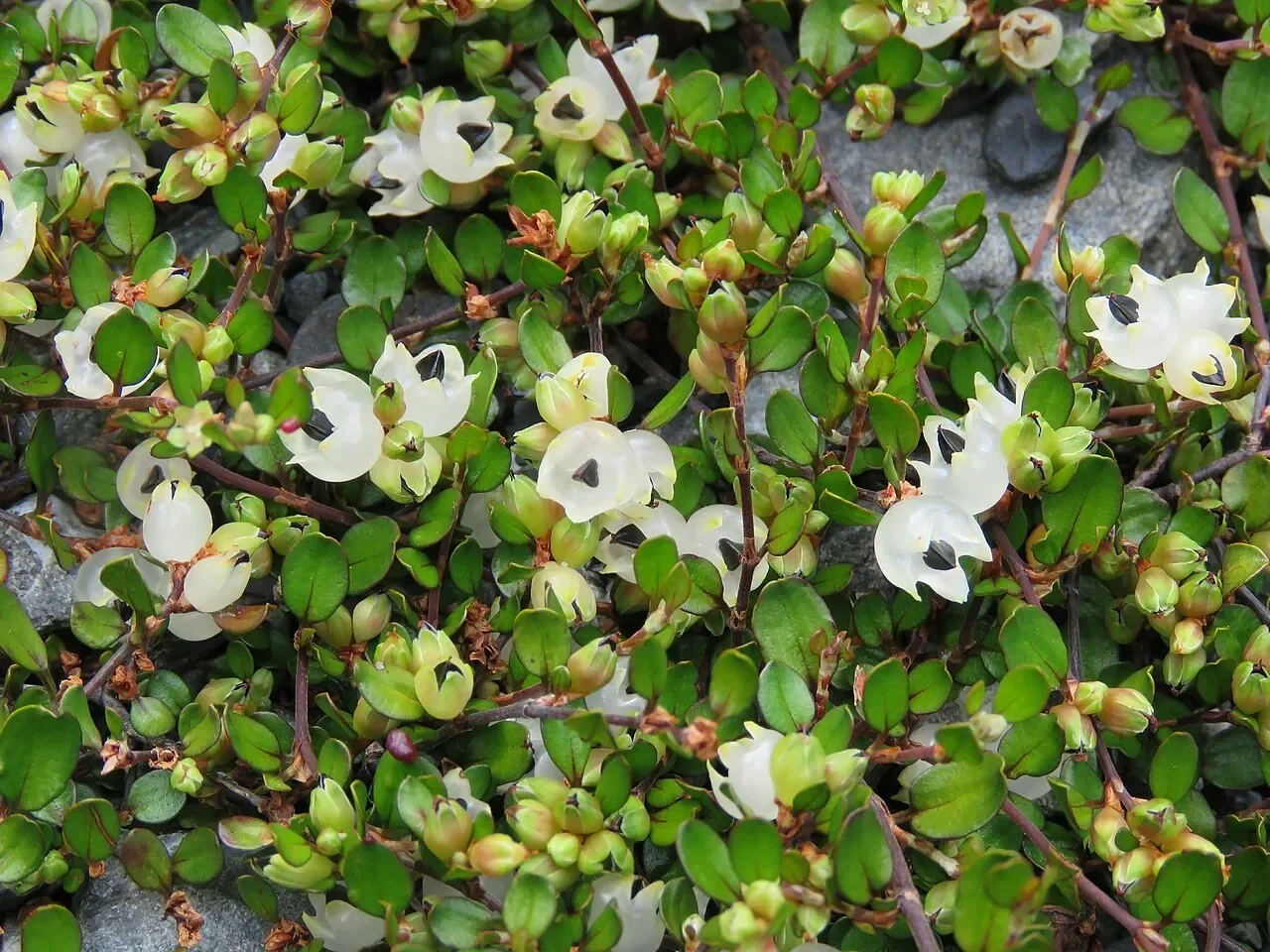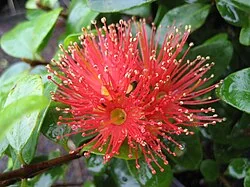
Scarlet Rata
Metrosideros fulgens
This native plant, known as Scarlet Rata (scientific name: Metrosideros fulgens), is a remarkable species endemic to New Zealand. It is characterized by its unique features, ecological role, and cultural significance. This comprehensive guide provides detailed information on its care, propagation, and importance within the New Zealand ecosystem. Understanding this plant contributes to the appreciation of our rich biodiversity and heritage. native trees

Plant Description
Botanical Features
Scarlet Rata (Metrosideros fulgens), also known as rÂātÄā vine or climbing rÂātÄā, is a forest liana or vine endemic to New Zealand. It can climb up to 12 meters or more when supported, or less commonly grow as a bushy shrub. It adheres to host trees using short adventitious roots, similar to ivy. The bark is red-brown to grey, often tinged with pink, and is flaky, separating into thick, squarish flakes. Its adult leaves are typically 40-60 mm long and 10-25 mm wide, elliptic to oblong, with a bright to dark glossy green upper surface. One of its most distinctive features is its vibrant flowers, which are typically scarlet (orange-red), though yellow varieties also exist. These flowers appear in rounded terminal clusters and are about 10-15 mm in diameter, with long scarlet stamens. The main flowering period is from autumn to winter, making it highly visible with its bright displays of flowers that can rise above the forest canopy.
Quick Facts
| Scientific Name | Metrosideros fulgens |
|---|---|
| Height | 15-20 m |
| Spread | 3-5 m |
| Water Needs | Moderate |
| Light | Full sun to part shade |
| Frost Tolerance | Moderate |
| Salt Tolerance | Moderate |
| Growth Rate | Medium |
| Lifespan | Long |
Climate Best Suited to
Scarlet Rata (Metrosideros fulgens) is primarily found in lowland to hilly forests across the North Island of New Zealand, extending to the Marlborough Sounds in the South Island. It demonstrates good adaptability to various conditions, thriving in areas with well-drained soils and tolerating both full sun and partial shade. Its natural distribution suggests a preference for warmer, more humid environments but with a reasonable tolerance for cooler temperatures found in its southern range.
Regional Suitability
| City | Climate Suitability |
|---|---|
| Whangārei | Ideal |
| Auckland | Ideal |
| Hamilton | Ideal |
| Tauranga | Ideal |
| Rotorua | Ideal |
| Gisborne | Ideal |
| New Plymouth | Ideal |
| Napier | Ideal |
| Whanganui | Ideal |
| Palmerston North | Ideal |
| Wellington | Ideal |
| Nelson | Ideal |
| Christchurch | Ideal |
| Dunedin | Moderate |
| Invercargill | Moderate |
Natural Habitat
Scarlet Rata is a climbing vine found in coastal and lowland forests throughout the North Island and on the west coast of the South Island. It thrives in warm, moist habitats and is often found climbing up tree trunks or over rocks in sunny ridges and forest margins.
Plant Conservation
Metrosideros fulgens, commonly known as scarlet rata vine, climbing rata, or akatea, is a forest liana or vine native to New Zealand. As of 2017-2018, Metrosideros fulgens is classified as "Threatened - Nationally Vulnerable" in New Zealand. This marks a decline from its previous "Not Threatened" status in assessments conducted in 2004, 2009, and 2012. The most significant threat to Metrosideros fulgens, along with other native myrtle species in New Zealand, is myrtle rust (Austropuccinia psidii), an invasive fungal disease that was first identified in New Zealand in May 2017. Currently, there is no effective method for controlling myrtle rust in wild populations, with fungicide application only being a last resort in very limited areas. Myrtle rust has been observed infecting Metrosideros fulgens both in natural environments and through experimental inoculation, demonstrating high levels of infection. Ongoing research is focused on understanding the susceptibility of various Metrosideros vine species to myrtle rust to inform future conservation strategies.
Growing Requirements
Soil Requirements
Scarlet Rata (Metrosideros fulgens) is remarkably adaptable to different soil conditions, thriving in well-drained environments. It can tolerate a variety of soil types, from sandy to loamy, and prefers a neutral to slightly acidic pH. Good drainage is crucial to prevent root rot, ensuring healthy growth and development.
- Tolerates a wide range of soil types from clay to sandy
- Prefers well-draining soils but can handle occasional waterlogging
- Thrives in moderately fertile soils but will grow in poor soils too
- Can tolerate slightly acidic to slightly alkaline pH
- Handles coastal conditions including salt spray
Light Requirements
Scarlet Rata (Metrosideros fulgens) thrives in a variety of light conditions, from full sun to partial shade. Optimal growth and flowering are typically achieved in locations receiving ample sunlight throughout the day. However, it can also tolerate some shade, especially in hotter climates, where it benefits from protection during the most intense afternoon sun.
- Full sun for optimal growth and form
- Can tolerate partial shade but may develop a leggier form
- At least 6 hours of direct sunlight daily is ideal
- Northern or eastern exposures work well in garden settings
Water Requirements
Once established, Scarlet Rata (Metrosideros fulgens) is remarkably drought-tolerant, requiring minimal supplemental watering. During its establishment phase, consistent moisture is crucial to encourage strong root development. Mature plants can withstand dry periods, but regular watering during prolonged droughts will promote healthier growth and more abundant flowering.
- Moderate watering during establishment (first 1-2 years)
- Drought-tolerant once established
- Can handle periods of soil saturation
- Reduce watering in winter when growth slows
- Signs of overwatering include yellowing leaves and crown rot
Planting Guide
When to Plant
The best time to plant Scarlet Rata is during the cooler months, from autumn to early spring, to allow root establishment before summer.
How to Plant
- Dig a hole twice the width and depth of the plant's root ball.
- Mix compost into your existing soil at a 50/50 ratio.
- Backfill the hole so the top of the plant's roots are level with the surrounding ground.
- Firm the soil gently and water thoroughly.
- In heavy clay soils, plant on a raised mound and use gypsum clay breaker to improve drainage.
Care and Maintenance
- Watering: Water regularly while the plant is establishing. Once established, it thrives with consistent humidity and prefers balanced moisture, typically requiring watering every two weeks, as it has moderate drought tolerance.
- Fertilizing: Apply a balanced fertilizer every 4-6 weeks during the growing season (spring and summer) for optimal growth and flowering. Reduce fertilization in fall and withhold in winter.
- Pruning: Prune lightly after flowering to encourage dense growth and maintain shape. The best time to prune is in early spring before new growth begins. Remove dead or damaged stems and thin overcrowded areas to improve air circulation and light penetration.
Ecological Role
RÂātÄā vine (Metrosideros fulgens) is a vigorous climber that links forest layers and delivers high-energy nectar to pollinators during flowering peaks.
Pollination Dynamics
- Nectar pulse: Showy blooms supply nectar and pollen for insects and birds, boosting seasonal food availability.
- Canopy reach: Climbing habit distributes flowers from understorey to canopy, improving pollinator foraging networks.
Habitat Contributions
- Structural complexity: Twining stems add perches, cover, and movement pathways for small fauna.
- Epiphytic support: Rough stems and aerial roots host mosses and invertebrates, enriching microhabitats.
Resilience
- Disturbance recovery: Rapid regrowth helps re-knit wind-damaged canopies.
- Pathogen awareness: As a myrtle, exposure to myrtle rust is a consideration; diverse plantings and airflow support health.
By stitching canopy layers and fuelling pollinators, rÂātÄā vine strengthens biodiversity and forest stability.
Uses and Significance
Garden Uses
- Specimen tree for visual impact
- Suitable for native gardens and restoration projects
- Enhances native garden aesthetics and biodiversity
- Provides architectural accent with its unique structure
- Effective for erosion control on slopes and banks
Landscaping Ideas
Scarlet RÂātÄā as a Feature Climber
- Pergolas and wires: Train long leaders horizontally to maximise flowering along older wood.
- Wild garden look: Allow to scramble through large, robust trees with periodic thinning to prevent smothering.
- Coastal gardens: Suits mild, maritime climates with shelter from severe frost.
- Containers: Large tubs with an obelisk can showcase flowers on sunny terraces.
Choose a warm, sunny aspect; a free-draining, moderately fertile soil supports sustained flowering without excessive soft growth.
Seasonal Care Calendar
Spring
In spring, Scarlet Rata (Metrosideros fulgens) begins its active growth phase. New foliage emerges, and it's an ideal time for planting new specimens or propagating. Ensure adequate moisture and monitor for early signs of pests.
- New growth begins with fresh foliage development
- Apply a balanced, slow-release fertilizer if desired
- Excellent time for planting new specimens or dividing offsets
- Monitor for new pest activity and address promptly
Summer
Summer is the peak growing season for Scarlet Rata (Metrosideros fulgens), often accompanied by flowering. Consistent watering is important, especially for young plants, to support vigorous growth and prevent stress during dry periods.
- Flowering typically occurs in early to mid-summer (November-January)
- Water young trees regularly during extended dry periods
- Avoid heavy pruning during the active growing season
Autumn
During autumn, Scarlet Rata (Metrosideros fulgens) prepares for the cooler months. Fruits or berries develop, providing food for native birds. It's also a good time for planting and general garden cleanup.
- Fruits or berries develop and ripen (December-February), attracting birds
- Natural leaf shedding occurs as part of its growth cycle
- Good time for planting new specimens to establish before winter
- Clean up fallen leaves if a tidy appearance is desired
Winter
Winter is generally a dormant period for Scarlet Rata (Metrosideros fulgens). Minimal care is required, though young plants may benefit from protection in colder regions. This is an opportune time for any necessary structural pruning.
- Generally dormant with minimal growth activity
- No special winter protection needed in most mild climates
- Suitable time for structural pruning if required
- Fallen leaves can be left as mulch or removed for tidiness
When to Prune and How Much
Scarlet Rata (Metrosideros fulgens) generally requires minimal pruning to maintain its natural form and health. Pruning should focus on removing dead or damaged growth and shaping the plant as needed.
- Remove dead, damaged, or diseased branches at any time of year
- Light formative pruning when young helps establish good structure
- To create a multi-trunked specimen, cut the main stem to encourage branching
- Fallen leaves can be removed for a tidier appearance, or left as natural mulch
- If necessary, lower branches can be removed to create clearance underneath
- Major pruning is best done in late winter to early spring before new growth
Always use clean, sharp tools for pruning to minimize the risk of disease and ensure clean cuts. The plant often responds well to pruning with vigorous new growth, contributing to a fuller, healthier appearance.
How to Grow Scarlet Rata
From Seed
Propagating Scarlet Rata (Metrosideros fulgens) from seed is a rewarding process, though it requires patience. Start by collecting seeds from the ripe capsules in autumn. The fine, dust-like seeds should be sown on the surface of a well-draining seed-raising mix. Do not cover the seeds with soil. Water the tray gently by misting and place it in a warm, sheltered spot with bright, indirect sunlight. Germination can be slow, taking several months. It is crucial to maintain consistent moisture levels without waterlogging the soil. Once the seedlings are large enough to handle, carefully prick them out into individual pots. Use a deep pot to accommodate the plant's developing taproot. Grow them on for a year or two before planting them in their final position.
From Cuttings
Scarlet Rata can also be grown from semi-hardwood cuttings, which is a faster method than growing from seed and ensures the new plant is true to the parent. Take cuttings in late summer or early autumn from healthy, vigorous shoots of the current season's growth. Cuttings should be about 10-15cm long and taken from a node. Remove the leaves from the lower half of the cutting to reduce water loss and dip the base in a rooting hormone to encourage root development. Insert the cuttings into a container filled with a free-draining potting mix. Place the container in a warm, humid environment, like a propagator or under a clear plastic bag, to maintain high humidity. Keep the mix moist but not waterlogged. Roots should form within a few months. Once the cuttings have a well-developed root system, they can be potted on into larger containers and grown until they are robust enough to be planted out in the garden.
Planting
When planting your Scarlet Rata, choose a site with well-drained soil and a sunny or partially shaded aspect. While it is adaptable to a range of conditions, it thrives in a cooler, moist root run. Before planting, prepare the site by digging a hole that is twice the width of the root ball and just as deep. Gently tease out the roots of the plant to encourage them to grow outwards into the surrounding soil. Place the plant in the hole, ensuring that it is at the same depth as it was in the pot. Backfill with soil and firm it down gently. Water the plant thoroughly after planting to settle the soil and eliminate any air pockets. It is important to keep the soil moist, especially during dry periods, until the plant is well-established. Applying a layer of organic mulch around the base of the plant will help to retain moisture, suppress weeds, and provide nutrients as it breaks down.
Pests and Diseases
Myrtle Rust and Common Climbersâ Issues
- Myrtle rust: Monitor new flushes; maintain airflow and avoid pruning during humid growth surges.
- Scale and sooty mould: Treat with horticultural oil; wash leaves to restore vigour.
- Leafrollers: Remove rolled leaves; birds assist natural control.
- Poor drainage: Causes decline in containers; ensure fast-draining mixes.
Cultural Significance
Metrosideros fulgens, also known as climbing rātā, holds significant cultural importance, particularly for the Māori people of New Zealand. The Māori have several names for the plant and its flowers, with 'aka' and 'puatawhiwhi' being commonly used for the plant and flower respectively. Europeans often refer to it simply as 'climbing rata'.
Cultural Significance and Traditional Uses:
- Tools and Construction: The vine was used as a flywheel on cord drills by Ngāti Porou and for binding adze handles. Along with kareao, it was extensively used for tying fences, platforms, and the heavy framework of houses.
- Medicinal Uses: Various parts of the plant were utilized for their medicinal properties. The juice was used as a cough mixture. Sap was applied for watery, inflamed eyes by the T� «hoe people. The inner bark from the eastern side of the tree was used to heal sores and stop bleeding. Bark boiled with rimu and kauri created a lotion for sore backs of horses, and bark steeped in water was used for ringworm. Sap from short lengths of vine was also blown on wounds.
- Refreshment: Bushmen would quench their thirst with the vine's juice, which was described as having a clear, bright pinkish hue and tasting somewhat like dry cider. The astringent juice was also consumed as a beverage.
Beyond its direct uses, Metrosideros fulgens is appreciated for its vibrant appearance, with bright orange to scarlet flowers that bloom from autumn to early spring, bringing color to the forest during winter. These nectar-rich flowers also provide an important food source for native birds and insects, and historically, native bats and lizards, contributing to the ecosystem's health.
Bonus Tip
Scarlet rÂātÄā (Metrosideros fulgens) sets the most blossom on older wood given ample light. Avoid hard summer cuts; instead, tidy after flowering, shortening only wayward leaders. Provide a warm, frost-sheltered aspect for yellow-flowered forms, which are a little less vigorous.
